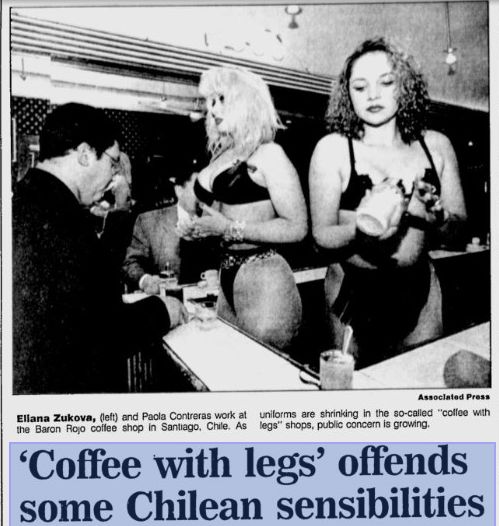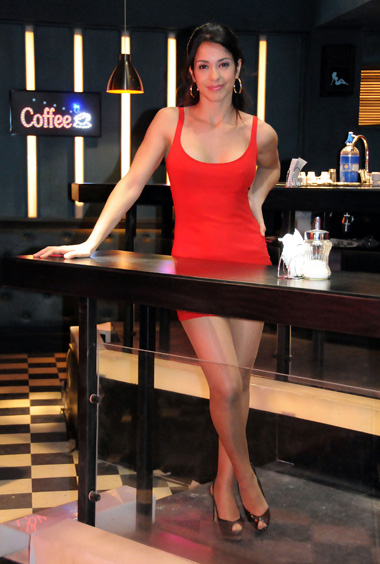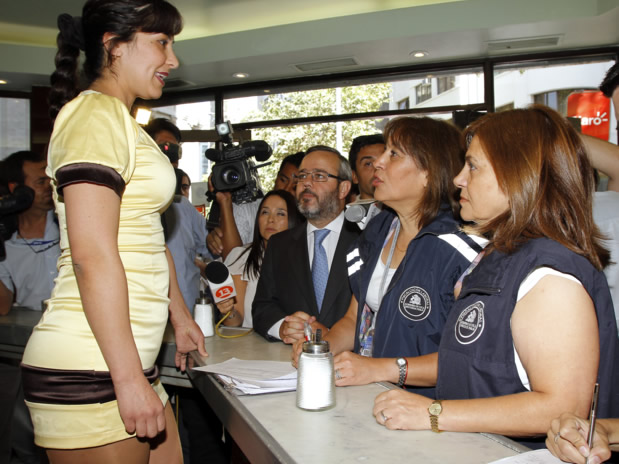╚►http://t.co/JUTtoQuMYZ★ SocioCulture #Coffee w/Legs ★http://t.co/nWazIwChXp★ #asmsg #T4US #aga3 #IAN1 #4ftm #bynr pic.twitter.com/qgXuT3QeHJ
— Thomas Jerome Baker (@profesortbaker) February 22, 2014
I Live In Chile, a country where the phrase, "Coffee With Legs", is a sociocultural phenomenon. As such, it must be looked upon using a wide-angle lens if it is to be understood properly within the context of a modern cosmopolitan city such as Santiago. The social aspects range from the workers, to the clients, and on to the owners of such establishments. Rounding all of this off is the obligatory issue of public perception. In sum, I will take a very brief, broad brush look at four points, namely, the workers, the customers, the owners, and finally, public perception. But first, the historical look is obligatory.
History of "Cafe Con Piernas"
Cafe Con Piernas, or Coffee With Legs, surprisingly, is not the proper starting point if a non-Chilean is to appreciate the full cultural expression of a café with legs. One must begin with a brief overview of Chilean history itself. This will become clear later as we see the development of this cultural phenomenon to its current cultural expression. So, let us begin, at the beginning...
Chile declared its independence on February 12, 1818. In the War of the Pacific (1879–83), Chile defeated Peru and Bolivia and won its present northern regions. It was not until the 1880s that the Araucanian Indians were completely subjugated. Although relatively free of the coups and arbitrary governments that blighted South America, Chile endured a 17-year military government (1973–1990) that left an estimated 3,000 people dead or missing. The precise number is unknown, and most likely, never will be known.
Currently, Chile is one of South America's most stable and prosperous nations. It leads Latin American nations in human development, competitiveness, quality of life, political stability, globalization, economic freedom, low perception of corruption and comparatively low poverty rates. It also ranks high regionally in freedom of the press and democratic development. However, it has a high income inequality, as measured by the Gini index. In December 2009 Chile became the first South American country to be invited to join the OECD. For more info on Chile, click here.
The First Cafés
There is a general consistency among the sources I consulted about the appearance of the first businesses selling café. I triangulated the info from the official web page of Café Haiti, newspaper reports, and personal testimony of Rebeca Fernández, who has worked for over 30 years in Café Haiti. The café has been in business since 1947. Café Haití claims to have originated not only the idea of drinking coffee at a thin, flat, stand-up counter, but also the idea of having the waitresses wear short skirts, showing their legs to the clients. The date given is winter of 1982, which means approximately May or June, when winter begins in Chile. (Source: La Tercera) During the summer months, the cities are practically deserted, as most people go to the beaches and the countryside for their vacation.
A final historical note is in order here. It has been suggested that this cultural phenomenon appeared after the military government had ended. It popularly posits the idea of a repressed sexuality of Chileans in general. Although that notion can not be entirely dismissed, it is incorrect to date the coffe with legs cultural phenomenon as coming after the government of Augusto Pinochet. In reality, it predates the return of democracy to Chile, as the military government was in place from 1973 to the end of 1989, sixteen years.
General Characteristics of a "Café con Piernas"
First, this is a business establishment where only women serve coffee to male clients, though women can, and do, go for coffee. Women usually go to the traditional, or "classic" coffee houses, the ones with several decades of history, such as Café Haití, for example. Mornings are the busiest times. No alcohol is served. They close at night.
The women serve coffee in bikinis or miniskirts and blouses, depending on company policy. The women work behind a thin, flat counter approximately 3 - 4 feet high, on a raised platform of 15 to 20 centimeters. This obviously leaves the male client's visual field centered between the navel and bust of the waittress, depending on her height.
As mentioned before, in the early 80's, at Café Haiti, the women began to wear short, tight dresses that hugged their body. In the classic cafés this tradition continues today. To this you add large, transparent windows, with the women's legs visible behind the counters, but with the faces generally not visible, behind a large strip occupied by advertising or non-transparent material. This is how the cafés got their name: Coffee With Legs (Café CON Piernas). (Source: Devanir da Silva Concha, "MASCULINIDAD Y CAFÉ CON PIERNAS ¿CRISIS, REACOMODO O AUGE DE UNA “NUEVA” MASCULINIDAD?", Universidad de Chile)
The Visual Aspect
Second, individuals cafes attract attention through a particular game with the visual. As you walk by, you can not fully see what is happening inside , apart perhaps from the legs you notice through the semi-transparent glass (some have a strip at approximately 5 feet high. It is usually is enough to cover the faces of most of the women. Again, that leaves visible the legs of customers and waitresses. Then, when you enter a coffee-with- legs, and become a client, suddenly, you see that there are mirrors everywhere, even the ceiling. This means then, that one from the outside does not have visual access to almost anything, but once inside, virtually every angle possible is covered to achieve visual access to the female body! Thus, we see that there is a symbolic play between the outside glass (separation) and inside glass (full visual access)(Source: Devanir da Silva Concha, "MASCULINIDAD Y CAFÉ CON PIERNAS ¿CRISIS, REACOMODO O AUGE DE UNA “NUEVA” MASCULINIDAD?", Universidad de Chile)
The Women
Who works in a Coffee With Legs? Rather than make general remarks, I will refer to the testimony of Rebeca Fernández, who has worked in Café Haití since 1982, located in Paseo Ahumada 140. More importantly, she has had a unique vantage point from which to observe the development of the industry. I quote Rebeca when she says:
Rebeca: I began when I was 18 years old. I thought I would only work 3 months. I never thought I would stay in this job for 30 years. I have seen that when it is cold and wet outside, we sell more coffee. But when the weather is warm and nice, we sell fewer cups of coffee. At first, in the 80's, our customers were lawyers, businessmen, and company executives. Over the years, this has changed.
For one, the city grew, and professional offices began to locate and relocate outside of the city center. Then in 1994, Miguel Angel Morales opened the Red Baron, with the first girls in bikini. Such was his success that his business model was quickly replicated.
The clash with the mayors and business regulations was inevitable. Everyone knew it was coming. Penalty after penalty, raid after raid followed. But it was not until 2002, under Santiago Mayor Joaquín Lavín, that the ongoing dispute was settled and a specific ordinance for these businesses was put in place (tinted windows, daytime hours, prohibiting the sale of alcohol and of course, prohibiting prostitution).
Today, there are only 191 registered in Santiago Centro and about 4,000 across the capital, according to the Coffees With Legs Association of Santiago (Asociación de Cafés con Piernas de la Región Metropolitana).
In the above report, it is stated that waitresses make minimum wage. It is the tips that provide the bulk of salary for the women. How much? As much as 10 to 15 times the basic salary can be made in tips alone.
Paola Contreras (22 years old): "This is the best job you can have these days" (1998). When asked about her personal dignity, she said, "A good job lacks dignity only if you lack dignity."
To this, waitress Eliana Zukova added, "Women wear even smaller bikinis at the beach. If you have a good body, there's nothing wrong with showing it."
Margarita Perez: "It's a well-paid job when jobs are scarce."
But what about wearing a bikini all day long, and being "eyed" up and down, from top to bottomm, front and back, by men, hungrily, with desire plainly evident, from all angles, all day long. Does it bother her?
Margarita: "No, not anymore. At first it bothered me, but now I'm used to it. It's like being at the beach." (Source: Youtube Video)
The women have adequately made their case, and I would say, eloquently, as well. At least in my case, the quote about personal dignity made me nod my head in assent. "Two points for you", I thought to myself. Although voices from the past can never be representative of current workers, we can be relatively sure that dignity in 1998 and in 2014 remains a stable concept, then and now.
Why Men Go to a Café Con Piernas
I again turn to the work of Devanir da Silva Concha. In his article, taken in part from his thesis, he gave several answers to this question. As you might expect, men across the entire age spectrum go to coffee with legs. Some seek companionship, an ear for problems that can be told to no one else. Others seek the erotic atmosphere of women scantily dressed serving coffee. To be sure, this is only a fantasy for the majority of Chilean men. Yet there is something deeper at play here.
Culturally, it's a masculinity issue, a rite of passage. When a boy becomes a man, a male figure of respect / authority introduces him into a man's world by taking him to a coffee with legs. In theory, it acts as a socializing element of the masculine identity. The theory holds that the boy is socialised in three forms, by opposition, to be a man. One, he is a man, not a woman. Two, he is a man, not a boy. Three, and quite possible the most important aspect of the coffee with legs, he is heterosexual, not homosexual. In sum, he is NOT a boy, NOT a woman, and NOT homosexual. (Source: Badinter, Elisabeth: XY: La Identidad Masculina, Alianza Editorial, Madrid 1993) For a detailed look at the sociocultural element of a coffee with legs, I recommend the work of social anthropologist Davenir da Silva Concha. He has studied this phenomenon in detail. A google translation can be found here, with errors in translation, but with the original meaning intact or easily inferred. The original article can be found here, in Spanish.
Let us now turn to the voice of a man, as he answers the question, Why do you go to a coffee with legs?
Patricio: "You have a very nice view here. Also you can talk with your friends about almost everything here." Source: Youtube Video
The Owner
The voice of the owner has not been heard yet. In general, anyone who owns a business does so to earn a profit. If it generates employment, it thus creates a benefit not only for the individual workers, but also the national economy as a whole. As in all forms of entrepreneurship, regulations establish the conditions of the workers, their rights, obligations, work hours, break periods, sanitary conditions, pay and benefits. This is true for the owner of a coffee house. Next, we will turn to the owner's voice. But before we do, keep in mind that high level surprise inspection visits are the norm, as we can see in the photo below of one such inspection visit. This is probably one of the most effective ways to keep owners honest, faithfully following all of the regulations. If this were not the case, things would quickly get out of hand...
Marco Peña: "Nowadays a coffee with legs is a lucrative business. You sell a lot of coffee and juice. When it is cold, it is cold. So, when a office worker leaves his office, he can have a cup of hot coffee and see a beautiful woman who will treat him well. (For his full remarks, see this Youtube Video.)
Public Perception
As recently as last week, in a conversation among male and female colleagues, the topic of what kind of man goes to a coffee with legs came up. A female colleague more or less made her views clear. According to her, only a man of low moral values would go to a coffee with legs. Surprisingly, I watched every man present assure her that they had never been to a coffe with legs. I admit that I also assured her that I had never been to one, although I quickly added that, "I have nothing against beautiful women." Thus reassured, the topic died down and moved on to other items of conversational interest.
Obviously, there are men that indeed have never, ever, set foot inside a coffe with legs, not even the more traditional, classic ones. Yet I sincerely believe they are in the minority in this country. As stated above, even social anthropologists recognize it as a rite of passage, a culturally acceptable way of passing from boyhood to manhood. Further, as in the example of Patricio above, you can talk to your friends there. It is also a quick getaway from the office stress as well, which explains the location of the coffee with legs mostly in the center of Santiago.
In sum, I raise no doubt on my colleagues. No man, in his right mind, would ever publically admit in the company of women, that they have ever been to a coffee with legs. As they say in Chile, "Un caballero no tiene memoria." A gentleman has no memory...
For the record, let me state publically, here and now, that absolutely none, nobody, no person, alive or dead, who I have ever worked with, at any job I have ever had anywhere in the world, nobody that I personally know, has ever been to a coffee with legs. Of course, neither have I. If it ever happened, I have no memory of it... (Case closed)
Public perception equates it (going to a coffee with legs) practically on a par with prostitution, which in fact, has often occurred in the past. Whenever the authorities become aware that this is happening, the coffee with legs is usually raided without warning, and if any evidence of prostitution is found, the business is closed down. From an owner's point of view, it is not worth the risk to lose your business, and generally, it is rare to find a coffee with legs that does not take care to prevent this. Yet as owner Marco Peña states in the Youtube video, "What a woman does in her spare time is her business." In sum, the public perception of the coffee with legs, of the people who go there and the people who work there is low. A final word: Their continued existence, in spite of the above, is a testimony to the sociocultural function it serves. Though it can not be said with any degree of accuracy, it is nevertheless quite clear that a societal need is filled.
Beach or Coffee? A Hard Choice in #CHILE!★ http://t.co/rHKhePL1g3 ★ http://t.co/nWazIwChXp ★ #asmsg #bynr #T4US pic.twitter.com/g2YPeaeGNm
— Thomas Jerome Baker (@profesortbaker) February 20, 2014







































































